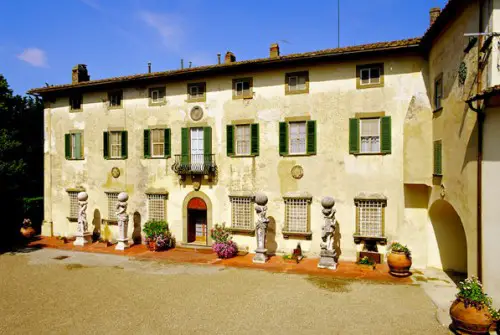by Pamela Marasco
Vin Santo is Tuscany in a glass and reflects Tuscan life at its best

D.H. Lawrence, the English author, poet, playwright and literary critic referred to Tuscany as “the perfect center of man’s universe”, high praise for a region only a little larger than the state of Massachusetts. Lawrence first traveled to Italy in 1912 and wrote of his travels reflecting on the meaning of life. In his writings about Tuscany, Lawrence mused about “a country so perfectly constructed where half the produce of five acres of land will support ten human mouths, yet still has so much room for the wild flowers”. Lawrence’s musings and meditative state must surely have been induced by a glass of Vin Santo, an amber colored sweet wine with a unique taste and velvety texture that is meant for sipping at the end of a meal. Vin Santo is made from grapes that are left late on the vine to condense and develop their sugar content resulting in a vino dolce; a smooth, intensely flavored sweet wine with a high alcohol content, usually about 16 to 18 percent.
Vin Santo is Tuscany in a glass and reflects Tuscan life at its best, life that is to be savored with a holy devotion to the grapes of the vine. Because of its name, Vin Santo (wine of the saints), the wine was thought to have originated as a sacramental wine. However there are other accounts that link the name to historical references that are less ecclesiastical. In particular to a certain incident in the 15th century when a visiting Greek prelate upon drinking it exclaimed “This is the wine of Xanthos”! Xanthos was mistaken for the word “santos” naming the wine Vin Santo. There are other reports that the name was derived from the accounts of a 14th century Franciscan friar from Siena who used it to cure the plague or was it a Carmelite monk who always carried a flask to ease the suffering of the sick. All I know is that Vin Santo has cured my overworked, overwrought psyche on more than one occasion and I continue to find it the end of a proper Tuscan meal.

 Although I have enjoyed many a glass of Vin Santo both in Italy and at home I always look forward to tasting the Vin Santo from Tenuta di Capezzana, an estate farm northwest of Florence. The Vin Santo from Capezzana is highly sought after and considered to be among the best of its class.
Although I have enjoyed many a glass of Vin Santo both in Italy and at home I always look forward to tasting the Vin Santo from Tenuta di Capezzana, an estate farm northwest of Florence. The Vin Santo from Capezzana is highly sought after and considered to be among the best of its class.
Selected white grapes (mainly Trebbiano) are held in baskets then strung together on cane stands where they are dried for several months then fermented and matured for over 4 years in caratelli, small cherry-wood, oak and chestnut barrels. The yield is very low, from 1/4 to 1/5 of the original weight of the grapes. At the time of my visit to Capezzana, the Vin Santo had already been bottled and sold but we were able to walk through the cellars and vinsantaie, a large ventilated room with many windows where the grapes are hung to dry. The windows in the room are opened and closed to control the flow of air. Here the grapes are subjected to seasonal temperature changes which create a unique taste and texture to the wine. At Capezzana the windows of the vinsantaie are opened and closed daily according to the winds and weather. There are other producers in Tuscany that make a notable Vin Santo including Avignonesi producing Vin Santo di Montepulciano.
Vin Santo is traditionally served with biscotti di Prato or cantucci from Siena. The cookies are dipped in the wine to soften, the adult version of Oreos and milk. Tuscans have been drowning their cantucci in Vin Santo since the time of the Renaissance. Tuscan bakers refined the recipe for the unleavened biscuits used by Roman travelers and served them with the local sweet wine. A marriage of form and function, the dry, crunchy texture and narrow shape of the cantucci were perfect for dipping and soaking up the flavors of the wine. Biscotti cantucci are hard twice baked cookies made with almonds (the name cantucci means “little stones”). Many bakery products in Italy were twice baked as a method of preservation. So don’t expect a soft, chewy chocolate chip cookie to dunk in a glass of milk. Instead pour yourself a glass of the wine of the saints and meditate about the history and tradition of a cookie that was a staple of the Roman legions and a wine that has a place of honor at the Tuscan table.
About the author:
Pamela Marasco is the founder and owner of Cositutti and CosituttiMarketPlace.com, a travel and lifestyle resource for Italian Food, Wine, Art and Design.